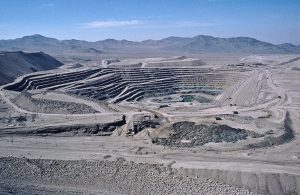7 Activity 2.1 – Politics of Copper and Lithium
Audrey Ricke and Elizabeth Kryder-Reid

Associated Readings:
Chapter 7, Marina Weinberg and Valentina Figueroa, Politics of Mining: Toxic Heritage in the Atacama Desert
Possible Additional Pairings:
- Chapter 8, Peter Carskadon Little and Grace Abena Akese, “Toxic Landmarking and Technoprecarious Heritage in Ghana.
- Visual Essay 2, Amelia Fiske and Jonas Fischer, “Translating and Transforming Toxicity: Moving Between Ethnography and Graphic Art.”
Targeted Skills:
Communication, Creativity, Library Research
Learning Goals:
- Identify global-local connections as it relates to lithium or copper.
- Practice communicating research data in an understandable way to the general public.
Directions:
Chapter 7 captures the complexities, paradoxes, and politics of the meanings associated with copper and lithium mining and their toxic heritage.
Option 1:
It can be challenging to convey such politics, contradictions, and complexities through words and at times even dangerous. Thus, it’s not uncommon for people to turn to art or performance to express and process such complexities and contentious politics, even at times using and playing with double meanings and symbolism. Conduct research using the data from chapter 7 and additional data you find about life in Chile and it intersections with copper and lithium. You may also want to identify a common item found in your own community that contains lithium or copper as components. Use this research to create a short graphic novel, song, or poem that tells the “behind the scene” story of the toxic heritage of the copper or lithium. Be creative in how you envision the main characters and who or what is telling the story. Represent multiple and conflicting perspectives and impacts, especially those within the same local communities featured in the reading. Did you pick a piece of tech? Check out Chapter 8 in this book for additional info on e-waste (the other side of the production process)
Option 2:
Use the data from chapter 7 and additional data you find about life in Chile as well as information about lithium and copper mining (see World of Lithium) to write an analytical essay about the stakeholders in copper and lithium mining. What do the various interested parties gain or lose? What are the costs and benefits for human and other-than humans in the extractive mining process? How does this particular case illuminate broader issues of toxic heritage?
Optional next step:
Share your creation or essay with peers, friends, and family (at least 3 other people) and ask and note their opinions and thoughts. Consider starting the conversation by asking them: what stood out to you and why? Ask them about what messages they are taking away from your work. Ask how the information you shared impacted the way they now view the commonly used item that is featured in your work. Explore what parts resonated the most with them and what parts were confusing and why. Ask how the confusing parts could be adjusted to help clarify.
-
Reflection and Analysis:
- How can the feedback you received from asking these questions help you improve or adjust your creative work to amplify your message or avoid miscommunication?
- What have you learned from this experience that you can apply to future projects involving public communication and education, whether in toxic heritage or other topics?

